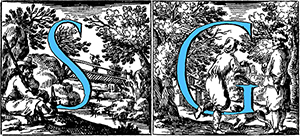
CARRACCI Annibale
(Bologna 1560 – Rome 1609)
Italian painter and engraver son of Antonio, a tailor born in Cremona who was transferred at young age to Bologna. Annibale was the younger brother of Agostino and cousin of Ludovico. Within his family he expressed the most innovative and fruitful artistic talent. In Bologna he studied the works of Beniamino Cesio, Orazio Samacchini and Prospero Fontana, in Parma, the frescos of Correggio and in Venice the paintings by Veronese and Bassano.
With Agostino and Ludovico founded in Bologna the Academy of the Incamminati, with the aim of bringing the painting out of the limitations of Mannerism, taking up various cultural backgrounds, the classical lesson of the Italian Renaissance, and at the same time, giving shape to a classic ideal and naturalist. It is not rare to observe in Annibalel the supremacy of the landscape that prevails in some works on the subject or scene represented.
In the first works done with his brother and cousin, it is difficult to recognize individual contributions, such as in the frescoes of the Fava, Magnani and Sempieri palaces in Bologna, where the ‘Carracci’ signature (without Christian name) is reported with the aim to indicate a collective work.
The monumental frescoes made in Bologna gave such a great renown to Annibale that Cardinal Odoardo Farnese gave him the task of decorating the noble floor of Palazzo Farnese in Rome.
This work, initially carried out with the help of Agostino, is a perfect fusion between the expressive techniques of poetic and fantastic narrative. Throughout the 16th and 17th centuries, the frescoes of Palazzo Farnese were considered the absolute masterpieces of the frescoes of the time.
Criticist Giovanni Bellori, in the 17th century, took Carracci as term of comparison of Italian painters, because he was the continuer of the great Renaissance tradition of Raffaello and Michelangelo.
No less important was Annibale’s contribution to the art of etching, although its production counts only twenty works, all of both artistic and tecnhical highest quality.
He died in 1609 and buried according to his wish in Rome in the Pantheon next to Raffaello’s grave.




